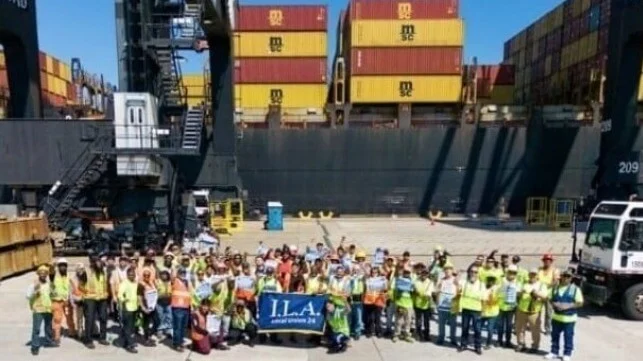The International Longshoremen’s Association (ILA) and United States Maritime Alliance (USMX) will resume their contract negotiations in November to resolve a new master contract for container and Ro-Ro operations at 36 U.S. ports along the East Coast and Gulf Coast. Earlier this month, the two sides extended the Master Contract after a three-day strike which was the first by the union since 1977.
“The ILA and USMX welcome the opportunity to return to the bargaining table and get a new agreement in place as soon as possible,” the two sides said in a joint statement released today, October 25. The two sides also pledged not to discuss details of negotiations with the media before these meetings after having waged a war of words in the media leading up to the strike that began on October 1.
Under pressure from the White House, and the Labor and Transportation departments, the two sides reached a tentative agreement on wages on October 3 that includes a 62 percent increase over the six-year contract. The Biden administration voiced its strong support for the union and the role the dockworkers play in the supply chain while pressuring terminal operators and shipping companies to improve their wage offer to the union.
The master contract was extended until January 15, 2025, with the sides set to return to the bargaining table. According to their statement, the first step will be to discuss all outstanding issues to reach a new agreement. The new master contract proposal would then be presented to the full ILA Wage Scale Committee for approval, and later, to ILA Longshore workers for ratification.
The key issue will be automation for container handling. The ILA has declared a firm position of no automation or semi-automation in any of the ports. One of the disputes this year was over the use of an automated gate system at the Port of Mobile which the union claimed violated its contract and threatened jobs.
The employers said publicly that they were proposing to maintain the current contract terms regarding automation. The process that is in place requires operators to propose any new automation which is reviewed and approved by a committee that includes union representatives. Asked about the level of automation at the Port of New York New Jersey, Port Director Beth Rooney said in a media briefing that there was none currently in use in the port complex, which is the third largest in the United States and the largest on the East Coast.
Observers hope after the significant wage increase that the next round of negotiations will be less contentious. However, the outcome could have a critical impact on the operations and efficiency of U.S. ports for many years to come.

